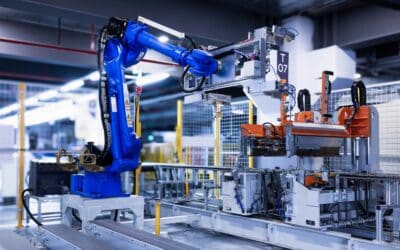Robots and automated processes are morphing into the industry standard. However, it is not always clear what the advantage of this automation should be. We show why it is worth taking new paths.
Industry 4.0, automation, robotization – the number of names and designations are legion. In this confusion, it seems all the more important to grasp the advantages of their application for one’s own company. That is why we would like to present our 14+1 best reasons for automated production and manufacturing in this article.
1. reduced time
Checking workpieces and operations manually is a time-consuming task that often takes up the lion’s share of a manufacturing process. When these tasks are delegated to a configured machine or robot, the time required per part decreases significantly.
2 Less work and lower costs
Clearly, if a machine takes over individual work steps or entire processes, the amount of work required of the previously employed personnel decreases. In this way, companies directly reduce their labor costs. Or they use the freed-up skilled workers in other areas to jointly achieve even higher added value.
3. lower error rate
No matter how experienced, focused and accomplished: We all make mistakes from time to time. When it comes to high-quality workpieces and products, this scrap can quickly become costly. Once set up, automated machines deliver consistent quality in return. The error rate drops.
4. fewer undetected production errors
To err is human. This is especially true for visual inspection of workpieces on the store floor. If employees inspect components in the same row all day long, their concentration inevitably drops. A workpiece quickly appears to be in order – although there is actually a defect. Depending on the overall situation, the rate of these undetected defects can rise to as much as 30%. An automated visual inspection, on the other hand, works according to fixed rules, without fatigue.
5. higher quality
Machines are often able to work more precisely than humans. Automation therefore increases the accuracy of fit and the quality of the workpieces.
6. higher consistency
Precision is not the only characteristic in which machines outperform humans: The quality of manufactured pieces also remains consistent at a level that makes it easier to calculate and plan.
7. higher customer satisfaction
Customer satisfaction also depends directly on product quality. If you reduce – or strictly sort out – your misproductions thanks to automation, you avoid disappointment. The satisfaction of your customers increases.
8. Enabling batch size 1
If you automate your production, you should already think about the next step: flexibility. This enables cost-effective production from batch size 1.
9. less risk to employees
Robots and machines offer employees a major advantage: They relieve them of heavy or even dangerous work – so fewer workplace accidents occur. They also drastically reduce employees’ exposure to harmful substances. As a result, fewer injuries and long-term damage occur, and the company benefits through lower medical costs.
10. better compliance
Machines only act according to their specifications. This is something your compliance department will certainly appreciate. After all, applicable guidelines on manufacturing, occupational safety and co. are easier to comply with in automated productions.
11. easy scalability
Business growth in a manual manufacturing environment? A costly process! Not only do you have to find and hire new employees, they also need a training period. It can take years or decades for employees to become masters in their field. If, on the other hand, production is automated, sometimes a faster production speed or a longer operating time is sufficient. For large-scale growth, all that is needed is another production line modeled on the existing one.
12. more employee satisfaction through variety
Offer your employees new tasks! Instead of performing just one step all day, have employees monitor and fine-tune the manufacturing machines. This requires different skills than before, but the more challenging work will energize your employees. Job satisfaction will increase.
13. discover unimagined employee potentials
When employees are no longer 100% occupied with routine tasks, new freedom is created. This often gives rise to new ideas or solutions to familiar problems, which employees can then implement directly.
14 Safe against pandemics
The last few months have shown it: a safe master plan is impossible. In automated production, however, employees no longer come so close. Additional advantage for times of crisis: Those who produce cost-consciously and automated in Germany have no problem with closed border crossings.
Bonus: Automation does not lead to mass unemployment
Contrary to popular belief, industrial automation in Germany is unlikely to lead to large-scale unemployment. That’s the conclusion of a 2019 research paper from the Leibniz Center for European Economic Research. Instead, they predict that we’re more likely to see mass job creation in the coming years. Companies can address this now – ideally directly when automated solutions are introduced.



